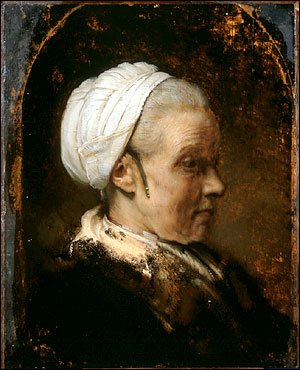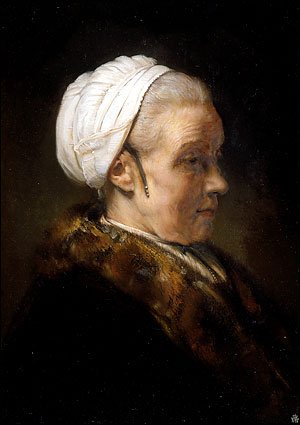Pentimento
Several times in recent memory, the restoration of an artwork has led to the re-attribution of a painting, or at the very least, the shift in attribution from a workshop piece to one executed directly by the master. Rembrandt and Titian are the authors of two major works “uncovered” during recent cleaning campaigns.
The discovery of Rembrandt’s unsigned study, Portrait of an Elderly Woman in a White Bonnet, was announced in September of 2005, restored solely under the guidance of Ernst van der Wetering, director of the Rembrandt Research Project, and Martin Bijl, previously of the Rijksmuseum in Amsterdam. No other scholars were consulted or offered the opportunity to view the work, which was set to be seen in the Rembrandt House in Amsterdam in celebration of the 400th anniversary of Rembrandt’s birth, celebrated this year.
It was determined that the painting had been touched up at a later date, and what had been identified as later repaint, including the sitter’s fur collar and the black background (which masked a change in the shape of the panel), were not congruent with Rembrandt’s original intentions. The restorers argued that another artist after the fact had modified Rembrandt’s painting in an attempt to sell it. Even though the painting had been excluded from Rembrandt catalogues since the early 20th Century, the restoration paid off — it sold for $4,272,000 at Sotheby’s this past January. Thus, as Rembrandt’s painting had been modified once in an attempt to sell the work, the same decision was made again, centuries later.

Rembrandt’s Portrait of an Elderly Woman in a White Bonnet – before restoration

Rembrandt’s Portrait of an Elderly Woman in a White Bonnet – after restoration
Bonnet has received the most attention, although there have been other Rembrandts that have entered the market in this manner. In 2003, a supposed self-portrait was found beneath a portrait of a Russian aristocrat, later selling for $11.3 million at auction. Largely responsible is the Rembrandt Research Project, which has more than once consulted with the owner of a newly discovered painting, and then worked with restorers to unveil what is considered to be an original Rembrandt. As fewer and fewer works by the master remain in private collections and fetch ever increasing prices, the incentive to find and authenticate “new” works from the underpaint of modified canvases is on the rise.
Things did not work out nearly so well for the supposed Titian double-portrait that was discovered under a painting depicting Tobias and the Archangel. Previously attributed to the great Venetian master, it had twice failed to sell at auction, first in 1947 and again in 1963.
As in the case of the Rembrandt, the “discovery” was made that the painting had been retouched by an inferior hand, in this case at the death of the master. Since the unfinished work was not saleable as it was — showing an unknown woman and her daughter — it was presumably modified into a religious subject so that it would have wider appeal on the market.
The nearly two-decade-long process of removing what had been deemed repaint had been begun as far back as 1983, and then the work was put up for auction as a Titian, yet again, this past December at Christies’ in London. Every effort was made to justify the importance of the painting
within Titian’s artistic output, with scholars and interested parties variously proposing that the mature female subject was one of Titian’s own daughters, his cousin, or his mistress. Although the sale price was estimated between $10 and $16 million, the bids failed to meet the reserve, and the work went unsold, as it had in its pre-restored state.
Interestingly, in both the cases of the Rembrandt and the Titian, the works were seen to be somewhat anomalous, something that should have raised a question as to either the authorship of the work beneath, or the original intentions of the artist. Without questioning Rembrandt’s authorship of <b>Portrait of an Elderly Woman in a White Bonnet</b>, it was noted that Rembrandt rarely posed his sitters in profile, that the bonnet was atypical of the master, and that the state of the work — an oil sketch — was less common for his oeuvre. For Titian, it was noted that this was the only mother-daughter portrait known by the artist. Yet even though both discoveries fell into the category of unique works, the traits that made them such were used as ways to increase the value of the works, rather than question their authorship.
The trend is likely to only increase. In February, it was announced that an original Frans Hals portrait of Pieter Jacobsz Olycan was discovered underneath heavy repaint that had caused the work to long be identified as a copy. Once worth just a few thousand pounds, it is now expected to fetch 7 million pounds at auction. In this case, the delay in identifying the true master of the work was exacerbated by the fact that Hals himself is believed to have changed the costume on his sitter, covering the original suit with a fur-trimmed coat.
While restorers have always been interested in the notion of discovery, uncovering heretofore unseen details of well-known works, this process of treasure-hunting on old master paintings is even more ominous. Good paintings will be destroyed at a faster pace, with the hopes — whetted by x-ray studies — of finding better, or at least more marketable, paintings beneath. As the art market clamors for more originals in what should be a finite pool, the temptation will grow to discover more works by the master painters, even incomplete ones, ones that the artist never intended to sell or show, hidden under the paintings of others.


